As soccer fans begin to rain down on Brazil for the Olympics, they need to know what to eat without spending a fortune. Many people don’t know how expensive Brazil can be–in São Paulo a meal at a decent restaurant can run $50 per person–but fortunately there is plenty of good and cheap food in Brazil. Street food and fast food are tasty, inexpensive and clean options.

The following cheap eats can be found at feiras (street markets) or botecos (small cafes), both of which are worth seeking out because they give a glimpse of authentic life in Brazil. And vegetarians will be happy to see that there are some options for them, too.

Pastel
Pastel (pronounced “pah-steh-oo” because any L at the end of a word is pronounced like a U) is a deep-fried pastry with your choice of filling (mozzarella and tomato, meat with cheese, etc.). This is a very common snack in Brazil and can be found both in street stalls and in small pastel shops. By the way, the plural is pasteis (“pah-stays”).
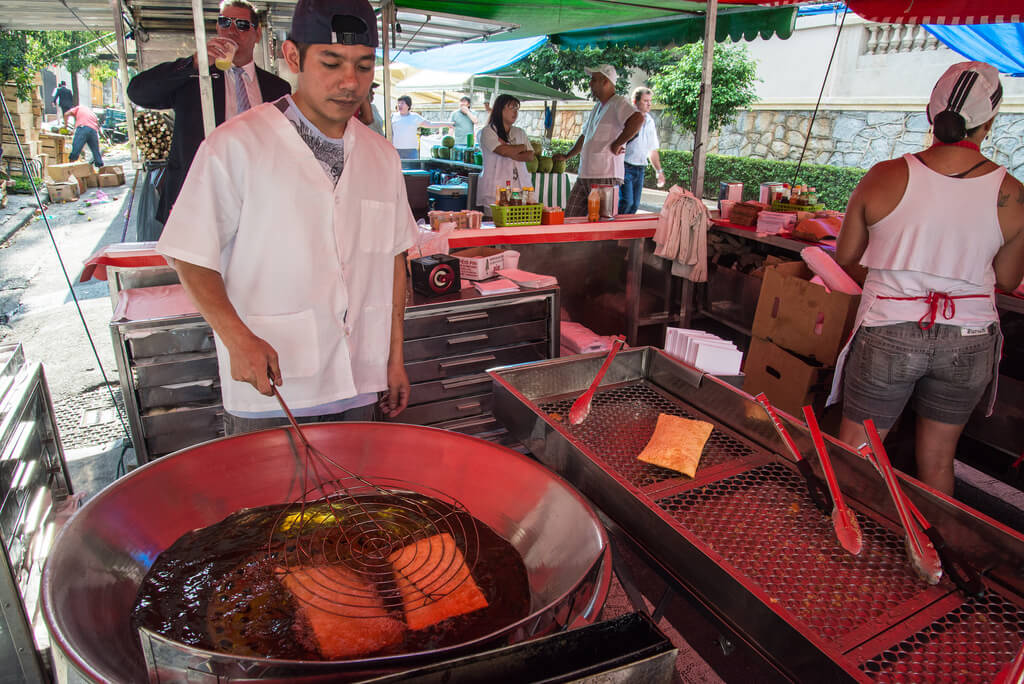
Hot dogs
Brazilian style hot dogs are different from American hot dogs because of the toppings. A common way to eat them is with mashed potatoes, but the variety of toppings gives you a lot to choose from, including vinaigrette (chopped tomatoes and onions in olive oil and vinegar), fried shoestring potatoes, and corn.
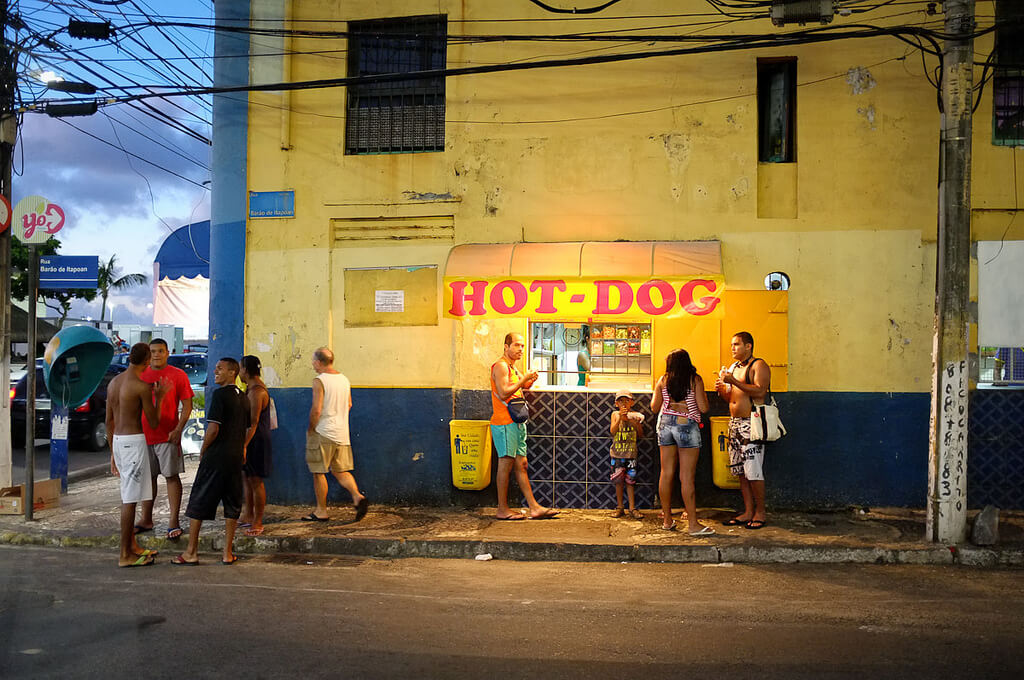
Empadinha, pão de queijo, coxinha, and esfiha
These are four of the most popular snack foods in Brazil. Sometimes we buy a few of them to make a small meal.
Empadinhas are mini pot pies usually filled with either chicken and peas or heart of palm with green olives.
Pão de queijo means cheese bread. It’s typically crunchy on the outside with a melted cheese center. If you can get them hot and fresh from a bakery, buy a bag full and enjoy.
Coxinhas (pronounced “ko-shee-nyaz”) are pear-shaped fried snacks with shredded chicken inside. Sometimes the chicken mixture has a Brazilian cream cheese mixed in; other times it can taste slightly spicy. Very good.
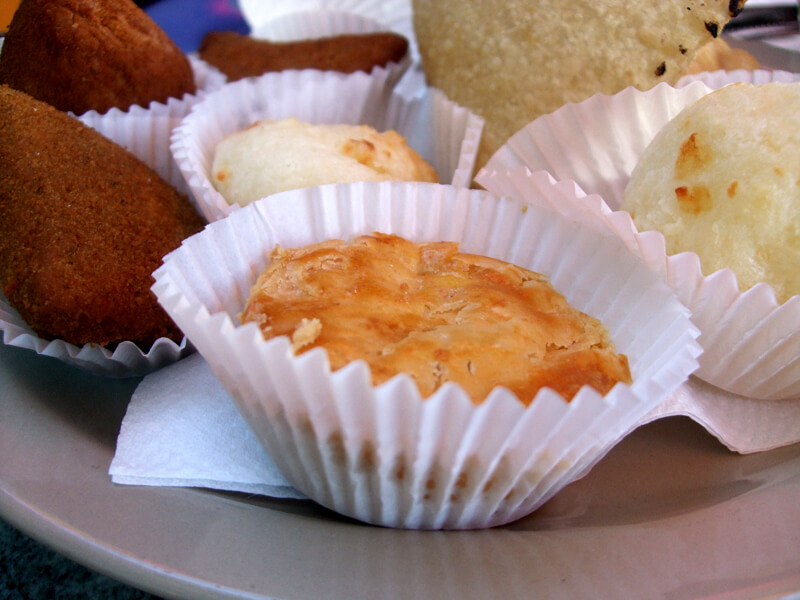
Esfiha is a Middle Eastern food that was brought to Brazil by immigrant groups from Lebanon and Syria. They usually resemble small flat pizzas but can sometimes be folded like a calzone. They’re typically filled with ground beef, but my favorite is with escarole (escarola) (shown below).
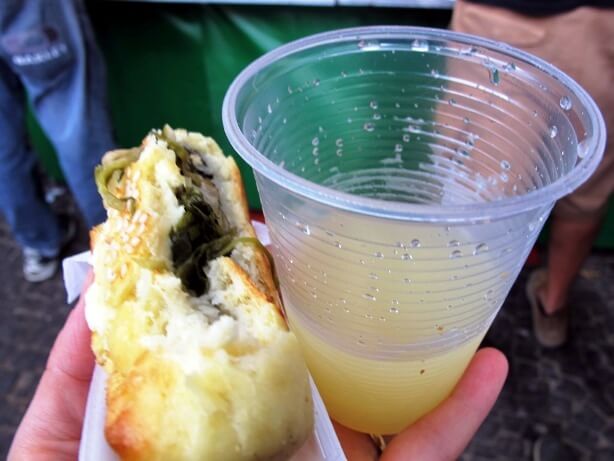
Acarajé
Acarajé is a typical dish from the state of Bahia in northeastern Brazil. It’s a fritter made from black-eyed peas, fried in dendê (palm oil, a staple ingredient of Bahian cuisine), and topped with a spicy paste and shrimp. This dish was brought to Brazil from Africa by slaves and is typically served by Bahianas, women from Bahia who wear a white dress and a headdress, making them easy to spot in street markets.
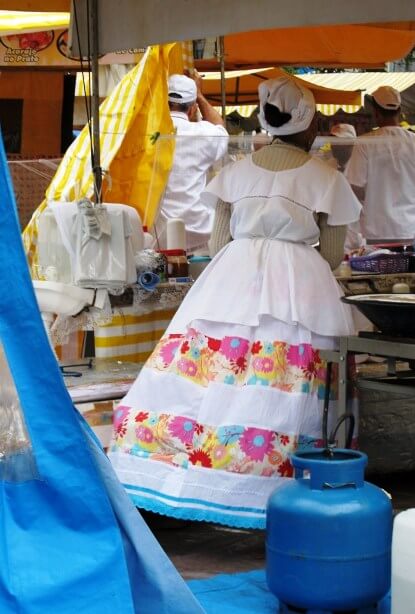
Even though acarajé is from the northeast of Brazil, it’s easy to find in cities across the country. We see it sold at every big street market in São Paulo.
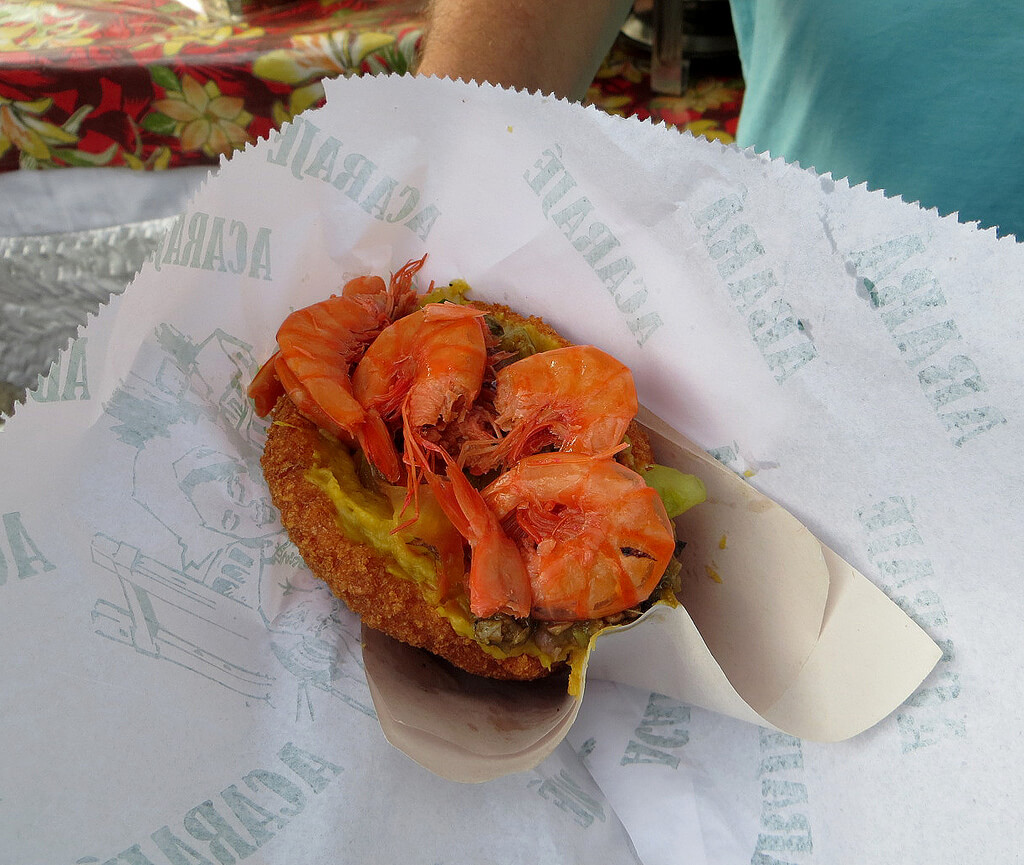
Nuts
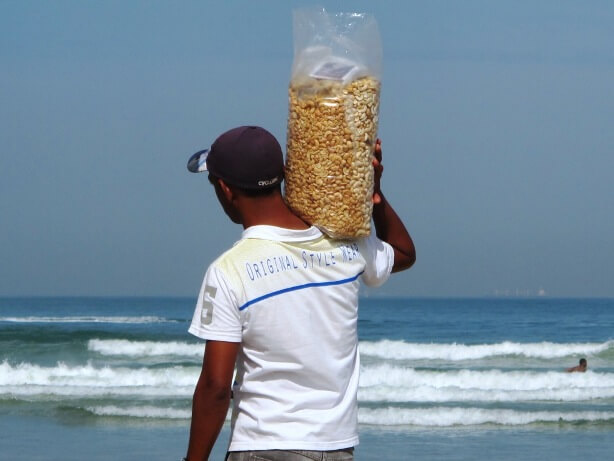
Nuts and fruit grow so abundantly in Brazil, so it’s common to see roasted nuts and even dried fruits and coconut for sale at outdoor markets. Cashews, Brazil nuts and peanuts are the most common types of nuts sold, and cashews and peanuts are very common snacks on the beach.
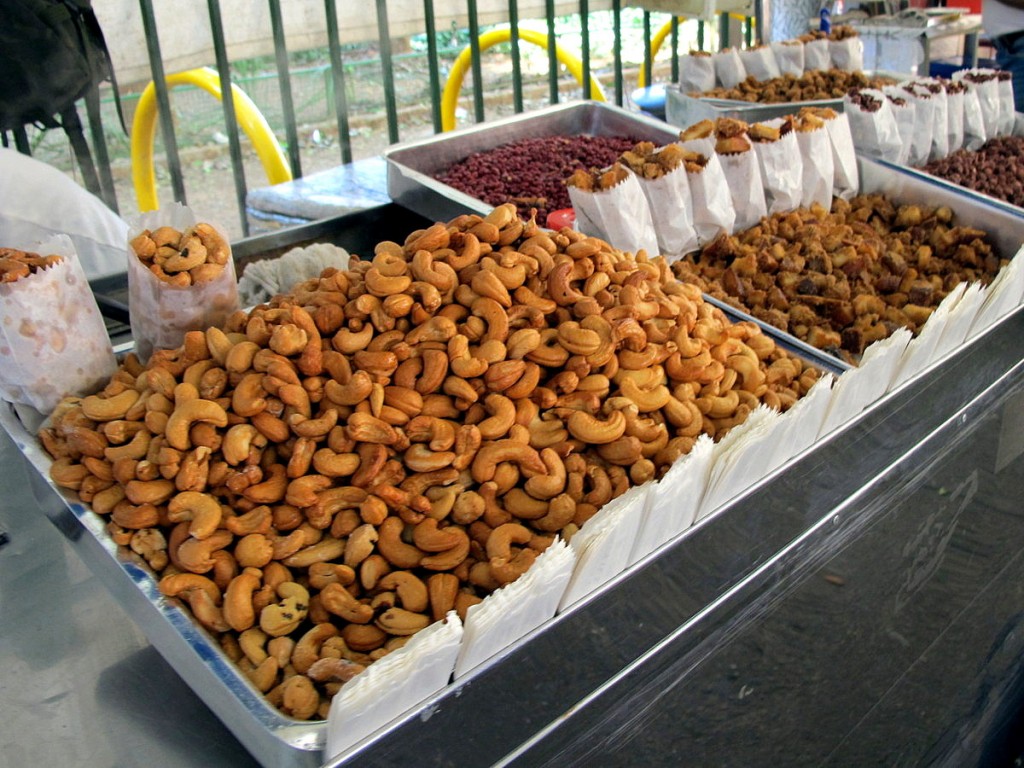
Fruit
Of course, because Brazil is a tropical country, a huge variety of fresh fruit is available. You can easily buy boxes of inexpensive fruit, such as mangoes, bananas, and guavas, at markets and even on street corners. Look for other varieties such as maracujá doce (sweet passionfruit, shown below), cajú (cashew fruit), and banana-maçã (apple bananas, small bananas that have a slight apple flavor).
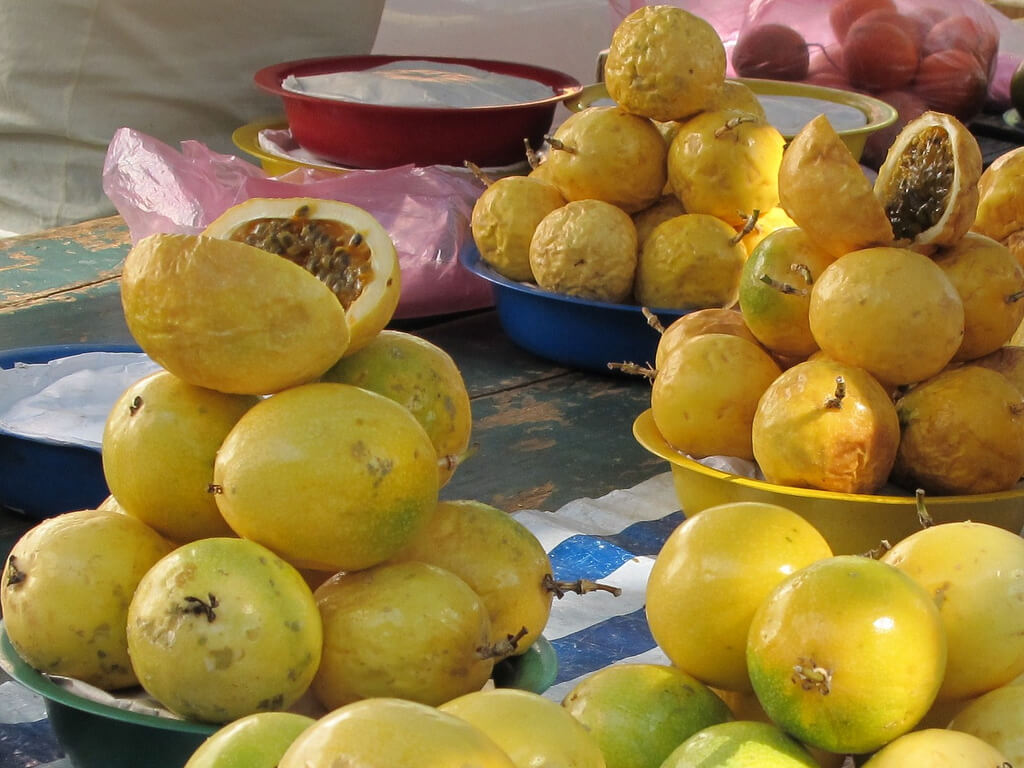
Drinks: Juices and coconut water
Three of the most common drinks sold on the streets of Brazil are fruit juices (sucos), caldo de cana (sugar cane juice), and água de coco, (coconut water). You can find them on many street corners from vans or trucks like this one:
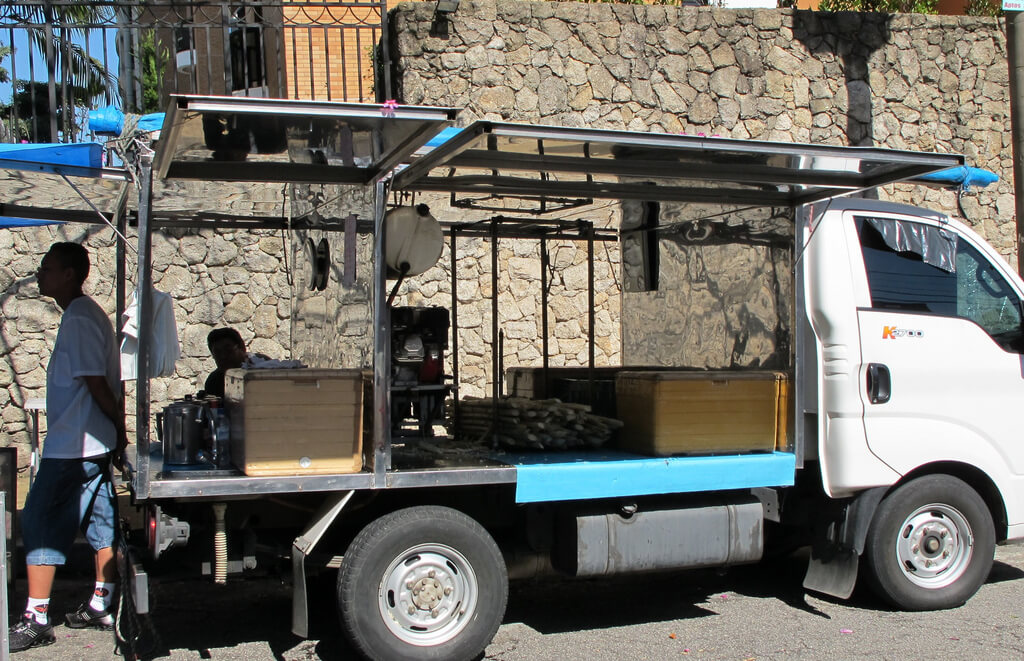
Sugar cane juice is very sweet and apparently is a low-glycemic way to get an energy boost.
Coconut water has been an acquired taste for me, but most people just love it, especially because it’s known for being an excellent way to hydrate. The flavor of each coconut is slightly different, some sweeter than others. However, always drink coconut water from a coconut, not from a cup, since the machines used to serve coconut water can be dirty.
Fruit juices in Brazil are amazing–my favorites are caju (cashew fruit), laranja com acerola (orange with acerola, a Vitamin-C packed combo that I have after arriving in Brazil), and the tart cupuaçu (“koo-poo-ah-soo”). The latter is one of many fruits from the Amazon that are used to make juices. They are often very tart without sugar and therefore are usually prepared with sugar, so if the person asks if you want sugar (“Com açucar?”), you should say “sim” or “um pouco.”
Beach snacks: Corn, açaí, & coconuts
Two common snacks sold on the beach are corn and açaí with granola (pronounced “ahs-eye-ee” with stress on the last syllable). I don’t recommend the corn, but I think my bias for sweet crunchy corn from the U.S. affects my tolerance for the Brazilian version.
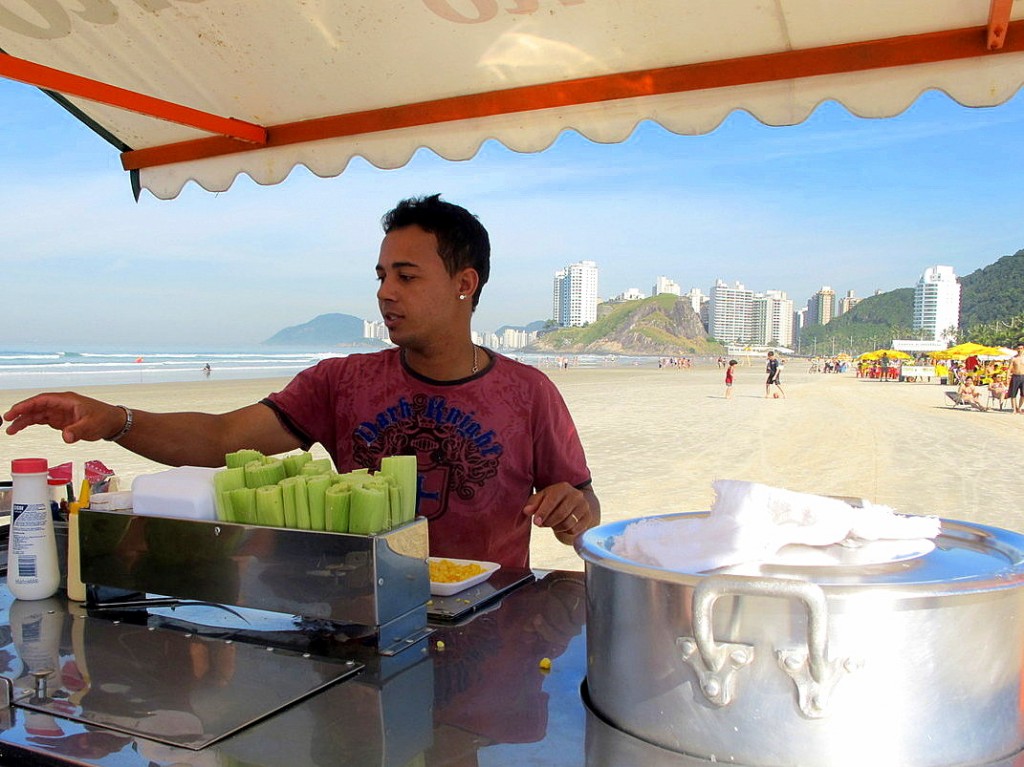
Açaí with granola, on the other hand, is a must when in Brazil and makes a perfect beach snack because it’s served cold and is refreshing and light.
And of course, no beach time is complete without coconut water, the perfect antidote to a hot day. In this case, after we drank the water, we asked the guy to cut them open so we could scoop out the “meat.” Delicious.
Pizza
You might not associate good pizza with Brazil, but in São Paulo, where a large Italian population settled, pizza is part of the city’s cuisine. The variety of pizza combinations is big, and toppings like egg might be new, but my favorite is arugula (rucula) and sundried tomatoes (shown below). Pizza is not exactly a cheap option, but they usually deliver quickly, or you can easily pick it up at one of the neighborhood pizza places.
What snacks would you like to try?

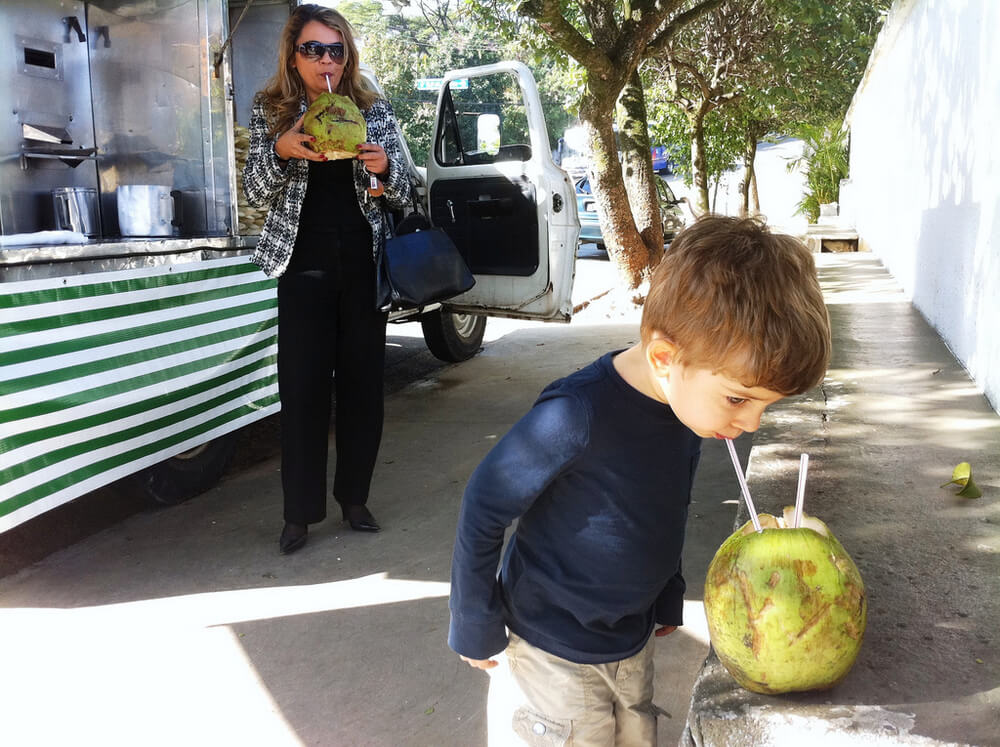
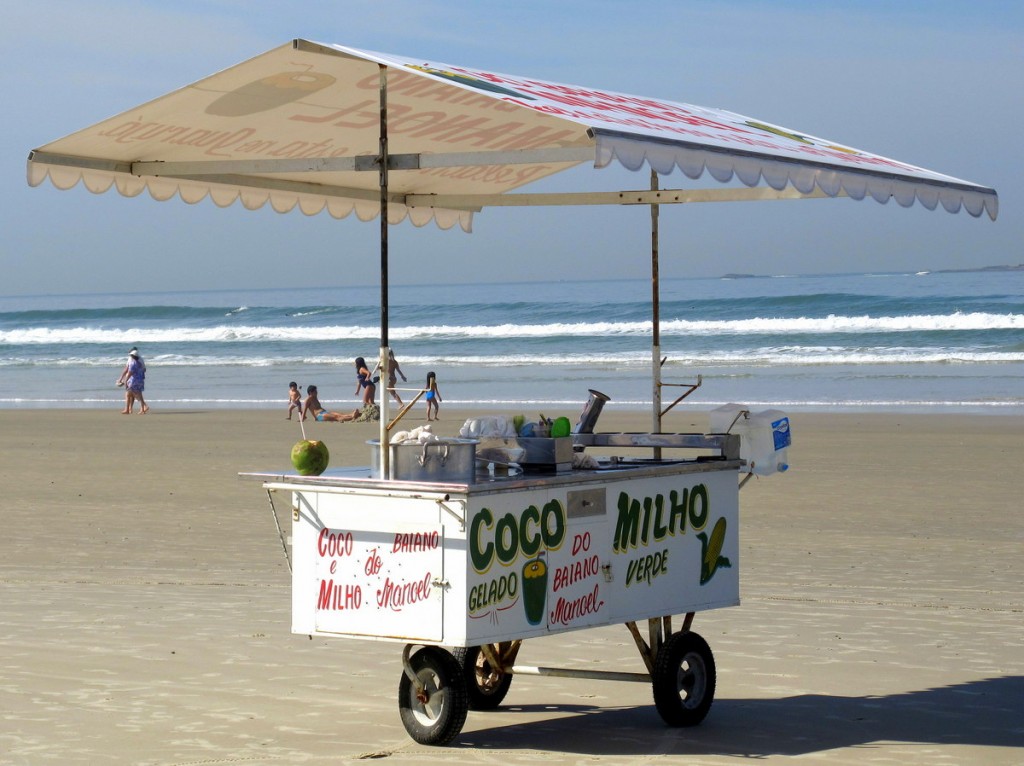
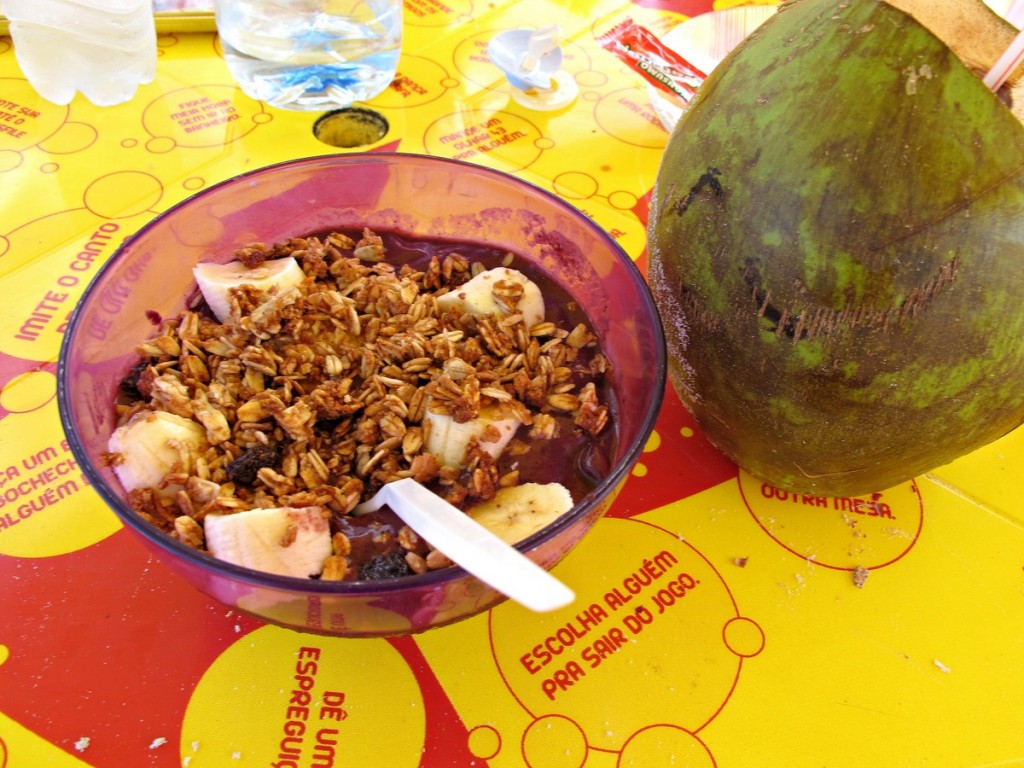
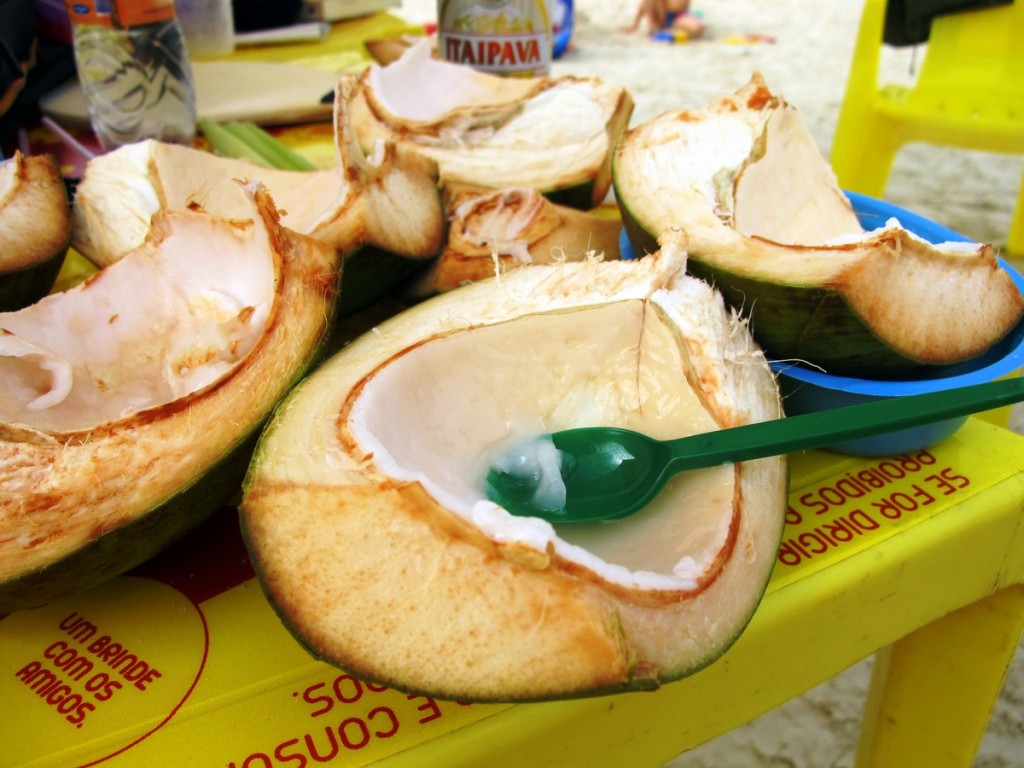
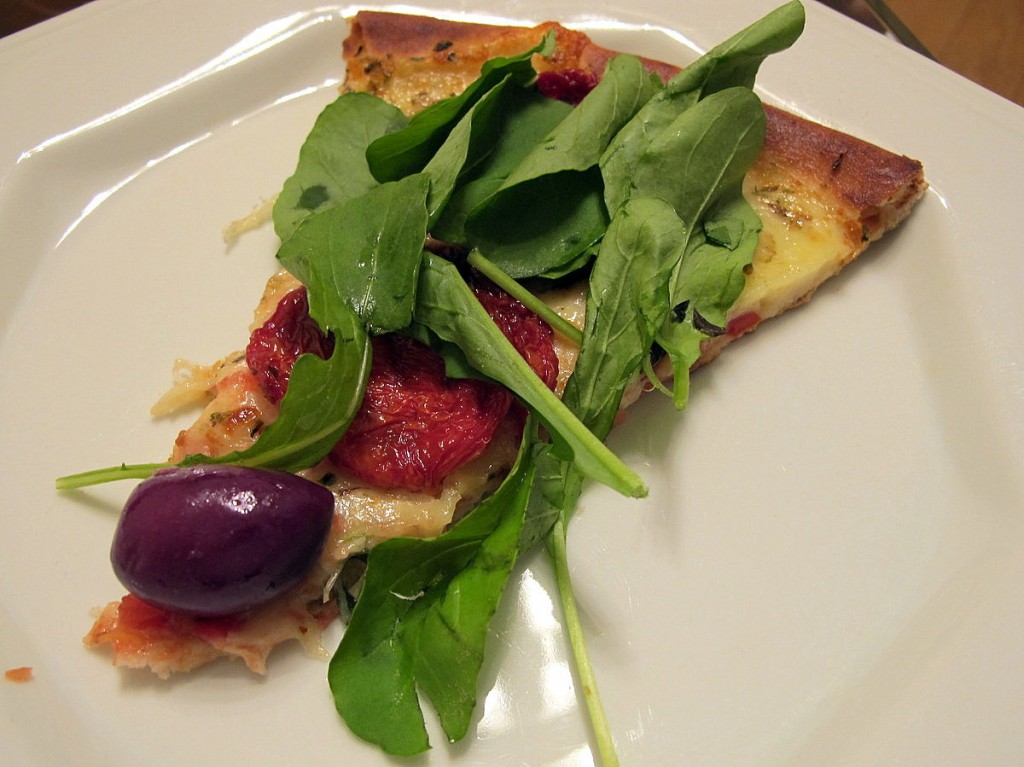



I’m heading to Brasil in September and I was already a little bit worried about the food scene there, especially that I’m not such a big fan of meat! Thank you Jenna for showing me I have nothing to worry about 🙂 and just looking at these pictures made me wanna skip few months and be already on the way there!! 🙂
How exciting that you’re going to Brazil! And you’ll be fine there. Lots of beans and rice + these snacks + smoothies.
Hi Jenna,
My Brazilian showed me this and I’m so happy that I had a look at it. I’m traveling to Sao Paulo for Christmas to visit a friend and you have made it more relaxed for me. I was a little nervous going there, as I’m Irish and very white I don’t want to be kidnapped, but looking at your adventure you have me excited!! Alan 🙂
I think you will enjoy it, especially if you’ll be there with a Brazilian. I have been many times and have never felt unsafe. 🙂
Ahhhh, I wish I was there right now! Great food, cheap or not. a caipi on the Copacabana is priceless!
Yeah, caipirinhas are hard to beat, especially in a beautiful place like Rio.
Okay, now that this delectable post has ruined my boring dinner plans for tonight, have you found any good/decent versions of these treats in (Northern) California? What about a go-to recipe site that you use?
Hee hee. So glad you enjoyed it. I have not found good versions of those treats in CA. I have a Brazilian cookbook but haven’t used it much. Honestly, because so many of the snacks are fried (I avoid fried food) or depend on tropical produce, I don’t think about making them here. You can buy pao de queijo (cheese breads) at some places in the Bay Area (so I’ve heard) or you can buy a mix and make them at home…not the same as fresh ones from the bakery but still a nice treat.
Lovely post! It’s reassuring to know some vegetarian things to look for in Brazil. Like Garrick, I’m interested in knowing if you guys have a Brazilian restaurant you love anywhere in NorCal? We’ve been to Pampas in Palo Alto a few times for the all-you-can eat meat skewers option (I get the salad bar)
Good question. There are not a lot of Brazilian people in the Sacramento area so there are very few Brazilian restaurants in this area. The Bay Area has some, I’ve heard, but they are probably all churrascarias (places that serve buffets and lots of beef) because those are the most typical Brazilian restaurants in the U.S. And yes, we are usually meat-free and do fine in Brazil.
So hungry now … obrigado for a tasty peek at Brazil!
You’re so welcome!
Love street food in a new country! Amazed at the variety flavor you exude in this post. Going to bed hungry now!
🙂 So glad you enjoyed seeing these foods!
Nice to relive some of the foods I tried in Brazil a couple of months ago – I really loved the Acai berry frozen yoghurt with granola – perfect for me on a shot day! I also loved the street side churros – you can see I have a sweet tooth! 🙂
The churros sound so good! I actually haven’t had them yet! The acai is actually non-dairy (or at least every variation of it I’ve seen)…just the frozen pulp of the fruit.
This is brilliant! You’ve got me taking notes as to what we need to look for when we’re in Brazil next week 🙂
So glad you will use it! We’ll be there around the same time. Enjoy your visit!
Not everyone will believe this, but I think I had the best pizza ever in Sao Paulo! I was actually pleasantly surprised by the food options for non-meat eaters all over Brazil!
I think a lot of people would no believe that, but I agree that it is very good!
All great recommendations! I’ll add two more to the list – a crucial tidbit for eating on the cheap is the “PF” – Prato feito – it means fixed plate, comes with salad, rice, beans, and some kind of meat, and is generally R$4-10. It may not be on the menu but most open air restaurants will serve it if you ask. Another tasty treat is picolé (Popsicles) – sold on the beach for R$1-2 and fantastic. Ahhh, saudade…
Do you recommend vaccines (as the CDC does) if we are to eat street food?
Good question. I can’t really recommend vaccines but would say that the street food in Brazil generally seems to be prepared in clean conditions. I hadn’t thought of street food and vaccines before, but then before this last trip to Brazil, we had to get vaccinated for yellow fever, and we decided to take the typhoid vaccine after it was suggested to us by the doctor. We took the typhoid vaccine several years ago before going to Indonesia, too. I basically take every vaccine that’s recommended for the area I’m visiting, but that’s just my preference.
I always hear from people how “expensive” Brazil is, i think it really on average must be more expensive than other Latin American countries. Then I just searched hostelworld in the last days and compared most cities in Eastern Europe, Asia and Latin America, surprisingly Rio de Janeiro has plenty 6 Euro hostel rooms and I even found one for under 4 Euro. Thats cheaper than in places like Cartagena or Medellin. Now I dont doubt that Rio de Janeiro is an expensive City still I was surprise by this result. Accomodation and Food are always the two biggest expenses once you arrived in a City. So if you eat like a local and live in a hostel you could easily “slum” it in Rio. The beach is for free thats most important, I am waiting for someone living out of a 4 Euro hostel in Rio to write an article like, living in Rio de Janeiro on “500 Euro” a month
Good point! I think people talk about Brazil being expensive first because it’s more expensive than people expect for a Latin American country, and second because a lot of hotels and restaurants are expensive. But you’re right about there being plenty of budget options as well.
Jenna, as a Brazilian, from Minas Gerais (land of Pão de Queijo), I wouldn’t describe these as well as you did. I love to eat and I definitely eat a lot everything you described, acarajé is my favorite. If you go to Belém (in the state of Pará) you can eat different açaí (that’s the original way of serving, in fact), it has no sugar or salt, it’s pure, served with fried fish and “farinha de tapioca” (tapioca flour).
It´s good to read so many good things from Brazil in these comments. Rio is a special place, indeed, and I go there a lot. At Carnival I am at Sapucaí representing Salgueiro, it’s too much fun. If you’ve never been to Rio for Carnival, I strongly recommend it. I live in Belo Horizonte and my city has wonderful Carnival, too, too many “blocos” that crowd the streets.
Thank you for all the info, Luciana! I’m looking forward to trying more foods and adding them to this list after my next trip to Brazil in December. I would love to go to Carnival in Rio someday; I have not gone yet.